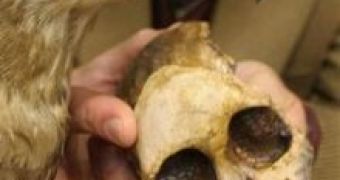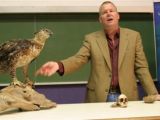One of the most famous human fossils, the Taung child, is believed to have been a three-year-old being at the time of its death, 2.5 million years ago. Its significance lies in the fact that this was the first of the fossils which had been found in the twenties and thirties to prove that the human species does indeed have a 'natural history' all of its own - just as Darwin had predicted. It also gave evidence that early humans evolved in Africa, rather than Europe and Asia, as most scientists believed at the time.
But how did he die? The mystery surrounding the Taung child's death has now been solved: he was killed by an eagle. This discovery suggests that human ancestors known as hominids were hunted not only by large predators on the ground but also by fearsome raptors that swooped from the sky, said Lee Berger, a senior paleoanthropologist at Johannesburg's University of the Witwatersrand.
"These types of discoveries give us real insight into the past lives of these human ancestors, the world they lived in and the things they feared," Berger said. "These are the stresses that formed the human mind and made us one of the most successful animals on the face of the planet."
In the past the child's death has been blamed on a leopard or saber-toothed cat, which are known to have preyed on hominids. But 10 years ago, Berger and fellow researcher Ron Clarke submitted the theory that the hunter was a predatory bird, similar to today's African crowned eagle. Berger and Clarke argued the skulls and bones of monkeys and other animal fossils found at the Taung site, about 300 miles southwest of Johannesburg, showed evidence of damage by eagles. Other researchers agreed eagles were likely preying on small animals at the site, but contended ape-men were too large, sophisticated and organized to be taken by a bird.
"The one big problem was the lack of multiple areas of damage on the Taung child itself that could be linked to a bird of prey," Berger said. "We had one little flap of bone on the top of the skull that looked like some of the damage we see made by eagles and nothing else."
However, five months ago, researchers from Ohio State University (Scott McGraw, Catherine Cooke and Suzanne Schultz) studied primate remains from modern crowned eagle nests in Ivory Coast's Tai forest and showed that raptors routinely hunt primates much larger than themselves by swooping down and piercing their skulls with their back talons. Berger called the study the most comprehensive to date of eagle damage on bones. There is even a documented case of an eagle killing a child, Berger said.
The Ohio State University paper identified key features that distinguished damage caused by eagles from that of other predators. They include the flaps of depressed bone on top of the skull caused by the birds' talon and keyhole-shaped cuts on the side made by their beaks, noted by Berger and Clarke in their 1995 paper.
But they also identified features previously never described: puncture marks and ragged incisions in the base of the eye sockets, made when eagles rip out the eyes of dead monkeys with their talons and beaks to get at the brains. Large predators can't reach inside the tiny sockets and instead crack open the skulls.
The study prompted Berger to re-examine the Taung skull. "I picked up this little face, and I almost dropped it. There was a tiny hole and jagged tears at the base of the eye sockets that he and over two dozen other researchers had never noticed. I think that we have conclusively proven, beyond a reasonable doubt that that is the killer of the Taung child," Berger said, looking up at a slide of an African crowned eagle. McGraw, a co-author of the Ohio State study, agreed "the evidence seems pretty compelling. There could be other agents responsible for a similar appearance, but I don't know what those are yet."
McGraw, who did not participate in Berger's study, said the next step was to put the Taung skull next to the Tai monkey skulls and look at the break edges more closely. So far, only photographs have been used.
Berger presented his research at a conference celebrating the 80th birthday of retired South African professor Phillip Tobias, who did pioneering research on the evolutionary links between primates and humans. It is due to be published in the February edition of the American Journal of Physical Anthropology.

 14 DAY TRIAL //
14 DAY TRIAL // 
